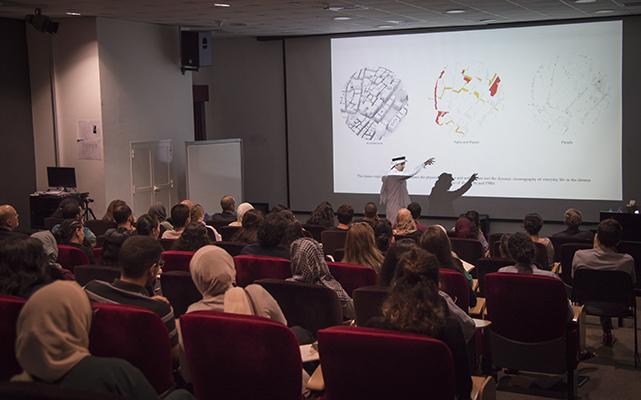- About
- Admissions
- Study at AUS
- Prospective Students
- Bachelor's Degrees
- Master's Degrees
- Doctoral Degrees
- Admission Publications
- International Students
- Contact Admissions
- Grants and Scholarships
- Sponsorship Liaison Services
- Testing Center
- New Student Guide
- File Completion
- New Student Orientation
- Payment Guide
- Executive Education
- Students with Disabilities
- Academics
- Life at AUS
- Research
- Contact Us
- Apply Now
- .

Dr. Khaled Alawadi lectures CAAD students on the effects of mega-urbanism in the region
The College of Architecture, Art and Design (CAAD) at American University of Sharjah (AUS) recently hosted Dr. Khaled Alawadi, curator of the UAE National Pavilion at the 16th International Architecture Venice Biennale, for a lecture on the juxtaposition of growing mega-urbanism and big architecture against the organic nature of human landscapes.
Dr. Khaled Alawadi spoke of “mega-urbanism versus the human scale” through the context of the Lifescapes: Beyond Bigness exhibition, which has featured within the UAE National Pavilion in Venice, Italy this year, and warned of the social and environmental effects of an architectural landscape that values “bigness” over accessibility.
Dr. Alawadi addressed the current state of architectural and infrastructural development in the UAE by referring to projects filling up the desert landscape that focus on their “bigness.”
While he acknowledged the remarkable and, in some cases, revolutionary, nature of these technological leaps, his lecture brought into focus the outcomes of leaving urban design to the private sector, traffic planning engineers and real estate developers.
Dr. Alwadi proposed that the result of this approach is a largely monotonous, repetitive display of big, bold architectural objects that are scattered throughout different parts of the UAE, lacking cohesive architectural logic and language in terms of their overall design.
The focus of the Lifescapes: Beyond Bigness exhibition, as Dr. Alawadi illustrated, is to encourage consideration for the ignored human scale, which is a result of the creation of the likes of mega blocks, gated communities and other large-scale developments. Such entities not only negate the physical human scale but are incomparable in terms of accessibility when compared to older, more organic landscapes in the different Emirates.
The content of the exhibition at the Venice Biennale was procured through meticulous research. This included multiple site visits to areas including Al Satwa, Baniyas and others to observe human interaction and organic movement through built environments that are not arranged or restricted by the rigidity of “landscapes of bigness.”
Apart from a survey of the physical attributes of different neighborhoods, behavioral patterns and ideologies in different urban frameworks were studied and natural landscapes were carefully mapped.
Dr. Alawadi stressed that Lifescapes: Beyond Bigness doesn’t propose to terminate “bigness” altogether. Instead, the underlying purpose of the exhibition is to celebrate the under-appreciated relationships that organically form between people and architectural spaces and objects. He maintains that an exclusive focus on conspicuous and loud urbanism does not support the practicalities of the human scale.
Ultimately the lecture highlighted need to elevate social and environmental factors and effects over economic development, urged a change in ideology in regard to urban planning in the region.
The 16th International Architecture Venice Biennale will continue in Venice, Italy until November 25 this year.
ENDS

